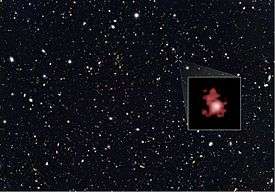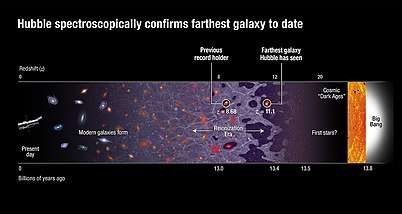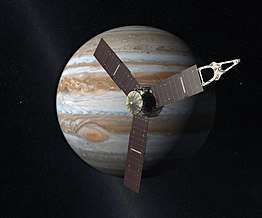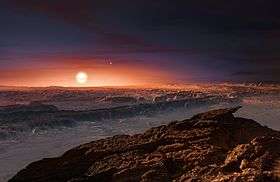GN-z11
GN-z11 is a high-redshift galaxy found in the constellation Ursa Major. The discovery was published in a paper headed by P.A. Oesch and Gabriel Brammer (Cosmic Dawn Center). GN-z11 is currently the oldest and most distant known galaxy in the observable universe.[4] GN-z11 has a spectroscopic redshift of z = 11.09, which corresponds to a proper distance of approximately 32 billion light-years (9.8 billion parsecs).[5][note 1] The object's name is derived from its location in the GOODS-North field of galaxies and its high cosmological redshift number (GN + z11).[6] GN-z11 is observed as it existed 13.4 billion years ago, just 400 million years after the Big Bang;[2][7][8] as a result, GN-z11's distance is sometimes inappropriately[9] reported as 13.4 billion light-years, its light-travel distance measurement.[10][11]
| GN-z11 | |
|---|---|
 GN-z11 superimposed on an image from the GOODS-North survey | |
| Observation data (J2000[1] epoch) | |
| Constellation | Ursa Major[1] |
| Right ascension | 12h 36m 25.46s[1] |
| Declination | +62° 14′ 31.4″[1] |
| Redshift | 11.09+0.08 −0.12[2] |
| Helio radial velocity | 295,050 ± 119,917 km/s (183,336 ± 74,513 mi/s)[3] |
| Distance |
|
| Apparent magnitude (V) | 25.8H |
| Characteristics | |
| Type | Irregular |
| Mass | ~1×109[2] M☉ |
| Size | 4,000 ± 2,000 ly (1,200 ± 610 pc)[2] |
| Apparent size (V) | 0.00042 x 0.001 |
| Other designations | |
| GN-z10-1,[2] GNS-JD2[3] | |
Discovery
The galaxy was identified by a team studying data from the Hubble Space Telescope's Cosmic Assembly Near-infrared Deep Extragalactic Legacy Survey (CANDELS) and Spitzer Space Telescope's Great Observatories Origins Deep Survey-North (GOODS-North).[12][13] The research team used Hubble's Wide Field Camera 3 to measure the distance to GN-z11 spectroscopically, by splitting the light into its component colors to measure the redshift caused by the expansion of the universe.[14] The findings, which were announced in March 2016, revealed the galaxy to be farther away than originally thought, at the distance limit of what the Hubble Telescope can observe. GN-z11 is around 150 million years older than the previous record-holder EGSY8p7,[6] and is observed (shortly after but) "very close to the end of the so-called Dark Ages of the universe",[14] and (during but) "near the very beginning" of the reionization era.[12]
Compared with the Milky Way galaxy, GN-z11 is 1⁄25 of the size, has 1% of the mass, and was forming new stars approximately twenty times as fast.[14] With a stellar age estimated at 40 million years, it appears the galaxy formed its stars relatively rapidly.[2] The fact that a galaxy so massive existed so soon after the first stars started to form is a challenge to some current theoretical models of the formation of galaxies.[12][14]
Notes
- At first glance, the distance of 32 billion light-years (9.8 billion parsecs) might seem impossibly far away in a Universe that is only 13.8 billion (short scale) years old, where a light-year is the distance light travels in a year, and where nothing can travel faster than the speed of light. However, because of the expansion of the universe, the distance of 2.66 billion light-years between GN-z11 and the Milky Way at the time when the light was emitted increased by a factor of (z+1)=12.1 to a distance of 32.2 billion light-years during the 13.4 billion years it has taken the light to reach us. See: Size of the observable universe, Misconceptions about the size of the Observable universe, Measuring distances in expanding space and ant on a rubber rope.
References
- "Hubble Team Breaks Cosmic Distance Record - Fast Facts". HubbleSite. March 3, 2016. STScI-2016-07. Archived from the original on July 6, 2016. Retrieved March 4, 2016.
- Oesch, P. A.; Brammer, G.; van Dokkum, P.; et al. (March 2016). "A Remarkably Luminous Galaxy at z=11.1 Measured with Hubble Space Telescope Grism Spectroscopy". The Astrophysical Journal. 819 (2). 129. arXiv:1603.00461. Bibcode:2016ApJ...819..129O. doi:10.3847/0004-637X/819/2/129.
- "[BIG2010] GNS-JD2". SIMBAD. Centre de données astronomiques de Strasbourg. Retrieved February 13, 2017.
- Klotz, Irene (March 3, 2016). "Hubble Spies Most Distant, Oldest Galaxy Ever". Seeker. Discovery, Inc. Retrieved February 5, 2020.
- Drake, Nadia (March 3, 2016). "Astronomers Spot Most Distant Galaxy—At Least For Now". National Geographic. No Place Like Home. Retrieved March 4, 2016.
- "Hubble Team Breaks Cosmic Distance Record". NASA. March 3, 2016. Retrieved March 10, 2016.
- Amos, Jonathan (March 3, 2016). "Hubble sets new cosmic distance record". BBC News. Retrieved March 3, 2016.
- Griffin, Andrew (4 March 2016). "Most distant object in the universe spotted by Hubble Space Telescope, shattering record for the farthest known galaxy". The Independent. Retrieved 17 December 2017.
- Wright, Edward L. (August 2, 2013). "Why the Light Travel Time Distance should not be used in Press Releases". University of California, Los Angeles. Retrieved March 10, 2016.
- Borenstein, Seth (March 3, 2016). "Astronomers Spot Record Distant Galaxy From Early Cosmos". Associated Press. Archived from the original on March 6, 2016. Retrieved May 1, 2016.
- "GN-z11: Astronomers push Hubble Space Telescope to limits to observe most remote galaxy ever seen". Australian Broadcasting Corporation. March 3, 2016. Retrieved March 10, 2016.
- "Hubble breaks cosmic distance record". SpaceTelescope.org. March 3, 2016. heic1604. Retrieved March 3, 2016.
- "Hubble Team Breaks Cosmic Distance Record". HubbleSite.org. March 3, 2016. STScI-2016-07. Retrieved March 3, 2016.
- Shelton, Jim (March 3, 2016). "Shattering the cosmic distance record, once again". Yale University. Retrieved March 4, 2016.
| Wikimedia Commons has media related to GN-z11. |
| Records | ||
|---|---|---|
| Preceded by EGSY8p7 |
Most distant known astronomical object 2016–present |
Current holder |
| Preceded by EGSY8p7 |
Most distant known galaxy 2016–present |
Current holder |


